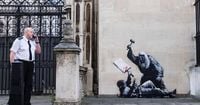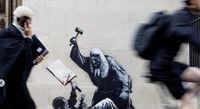On the morning of September 8, 2025, Londoners passing by the imposing façade of the Royal Courts of Justice were greeted by a striking new mural — and it didn’t take long for the world to take notice. The artwork, unmistakably in the style of the elusive street artist Banksy, depicted a judge in full legal regalia poised to strike a protester lying helplessly on the ground, the protester’s sign splattered with red paint that seemed to symbolize blood. Within hours, the piece had sparked a flurry of speculation, condemnation, and, inevitably, official action.
Banksy, who has built a global reputation for his provocative, politically charged murals, confirmed authorship in his trademark fashion: a post on Instagram. The caption was simple, reading "Royal Courts of Justice. London." That was all it took to set social media alight and send journalists, activists, and art lovers flocking to the scene. But by midday, the mural was already being concealed, covered in large sheets of black plastic and cordoned off by metal barriers. Security personnel stood guard, and CCTV cameras kept a watchful eye — a dramatic response to a piece of art that had barely had time to breathe.
According to Metro, the mural was reported to police as criminal damage the same day it appeared. The Metropolitan Police confirmed, "On Monday, officers received a report of criminal damage to the side of the Royal Courts of Justice. Inquiries continue." The council, tasked with maintaining the historic site, quickly announced that the mural would be removed, though the exact timing and method remained unclear.
The urgency of the removal, authorities explained, stemmed from the building’s status as a Grade I-listed (or Grade II-listed, as some sources note) Victorian Gothic revival structure, now 143 years old. HM Courts & Tribunals Service (HMCTS) stated, "The Royal Courts of Justice is a listed building and HMCTS are obliged to maintain its original character." In the UK, such listed buildings are among the nation’s most significant heritage sites, legally protected to ensure their preservation for future generations. This obligation, officials insisted, left them with little choice but to act swiftly.
But while the official explanation focused on heritage, the mural’s content — and its timing — made it impossible to ignore the political undercurrents. The image, many argued, was a clear commentary on the UK government’s recent ban of Palestine Action, a campaign group that had been designated a terrorist organization in July 2025 after activists damaged military aircraft in protest of British support for Israel’s actions in Gaza. The ban placed Palestine Action on the same legal footing as groups like Al Qaeda, a move that ignited fierce debate over civil liberties, protest rights, and the boundaries of dissent.
The weekend before the mural appeared, nearly 900 people were arrested during a demonstration supporting Palestine Action. Protesters, many sitting peacefully outside Parliament and holding signs that read "I oppose genocide. I support Palestine Action," were met with a heavy police presence, as reported by Metro and other outlets. The sheer scale of the arrests — almost 900 in a single day — drew sharp criticism from rights groups and fueled speculation that Banksy’s mural was a direct response to what many saw as an escalating crackdown on protest in the UK.
Defend Our Juries, an organization that has been vocal in opposing the ban and organizing demonstrations, issued a statement to Metro describing the mural as a powerful indictment of government overreach. "Banksy’s piece powerfully depicts the brutality unleashed by Yvette Cooper on protesters," the group declared. "When the law is used as a tool to crush civil liberties, it does not extinguish dissent – it strengthens it." They added, "As Banksy’s artwork shows, the state can try to strip away our civil liberties, but we are too many in number and our resolve to stand against injustice cannot be beaten – our movement against the ban is unstoppable and growing every day."
For many, the episode was a microcosm of the broader tensions roiling the UK in 2025. On one side, government officials and some members of the public argue that the ban on Palestine Action was a necessary response to criminal acts — notably, the damaging of military planes at a base. The government contends that the group crossed a clear legal threshold, justifying its designation as a terrorist organization. On the other side, civil liberties advocates and a considerable segment of the public see the ban, and the subsequent mass arrests, as a dangerous slide toward authoritarianism. They point to the chilling effect on free speech and the right to assembly, echoing concerns raised by a High Court judge who allowed a legal challenge to the ban to proceed.
The legal battle over Palestine Action is ongoing. After initial appeals by the group were rejected, a High Court judge permitted the case to move forward, though the government is now challenging that decision. As reported by BBC and Metro, the outcome could have significant implications for protest rights in the UK, especially as authorities grapple with how to balance national security concerns with the fundamental freedoms enshrined in British law.
Banksy’s mural, meanwhile, became an instant flashpoint. While some saw it as vandalism — hence the swift police response — others viewed it as a vital act of public commentary, entirely in keeping with the artist’s history. Banksy’s work has long tackled political issues, from migration and war to the treatment of marginalized groups. Recent pieces have included an inflatable raft of migrants at Glastonbury Festival, "The Migrant Child" in Venice, and numerous murals in the West Bank and Gaza. His art often appears in places where tensions are highest, sometimes vanishing almost as quickly as it arrives.
As for the mural at the Royal Courts of Justice, its fate seems sealed. The council and court authorities have made clear that its removal is imminent, citing the need to protect the historic building’s character. But for those who managed to glimpse it before it was covered, the image lingers — a stark reminder of the ongoing struggle over protest, power, and public space in modern Britain.
Whatever side of the debate one lands on, it’s hard to deny that Banksy has once again succeeded in forcing a conversation — not just about art, but about the kind of society Britain wants to be. The mural may soon be gone, but the questions it raises are likely to persist for a long time to come.


